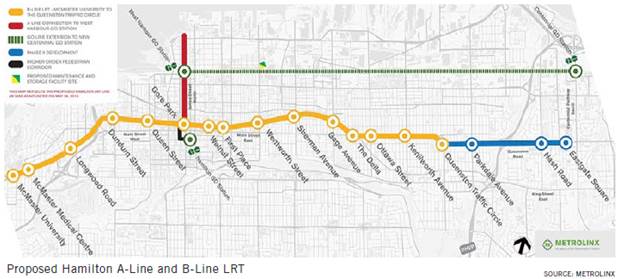
Hamilton LRT Citizen’s Jury
NRU
Dec. 16, 2015
George Liu
The City of Hamilton has assembled a citizen’s jury to provide input on the 11-km B-Line LRT that will connect communities and invigorate downtown Hamilton.
“The citizen’s jury was convened to get an early pulse on what citizens think about the LRT in the pre-consultation phase of the project,” consultation project manager Tim Dobbie told NRU. The citizen’s jury is composed of citizen members from each of Hamilton’s 15 wards who will hear experts talk about past experience and will participate in discussions about how the LRT will affect their city.
Members of the citizen’s jury had the opportunity to hear speakers share their experience with similar projects such as the Eglinton Crosstown in Toronto and the ION LRT in Waterloo. Learning from these experiences, the jury will provide input as the higher-order transit network is implemented in Hamilton.
“The jury’s work is focused on providing advice to council and making recommendations on the challenges and opportunities that will arise from implementation of the LRT. [Its] work is expected to be completed by the spring when [it] submits [its] recommendations to council,” Hamilton policy and public affairs advisor Kwab Ako-Adjei told NRU.
Despite $1-billion in funding from the provincial government, announced last May by Premier Kathleen Wynne, not everyone supports construction of the B-Line LRT.
“The people in ward 1 are divided [about the LRT]. Half the people in ward 1 are onboard for LRT. Th ey get the arguments about the health and environment. But the other half is very skeptical. Working behind all this, it is my own view that we have to do complete streets planning as part of LRT, both to get people to LRT, and to recognize that not every trip that people need to make are trips they can make along the LRT corridor. We do have to be facilitating cycling, walking and car driving [as alternatives],” said ward 1 councillor Aidan Johnson.
Aware of citizens’ concerns, Hamilton is framing the LRT conversation around the positive economic development benefits that higher-order transit will bring to the city, rather than solely about the movement of people.
“It’s important for us to remember that LRT is not a project to solve congestion, it is a city building initiative,” LRT coordination director Paul Johnson told the citizen’s jury. “When you look at the evidence, where LRT connects a revitalizing downtown area to desirable adjacent areas, you see good development opportunities. In Hamilton, that is exactly what we are doing.”
New proposals for retail and residential development in downtown Hamilton reflect a positive market response to revitalizing downtown Hamilton. To facilitate further study, Johnson says the city passed an interim control by-law in October that temporarily halts low-density development along the proposed LRT corridor.
“We do want to pause a moment, [for] a 12-month period, where we can take our time and ensure that we are building the right kind of approach for that important transit corridor. It is simply not helpful to the overall planning and development opportunities before us to have auto-centric buildings and facilities being built along a corridor that is being designed for transit.”
Tim L. Dobbie Consulting was the successful proponent to manage the citizen’s jury process. Consultant Steer Davies Gleave has been retained to update the original submission to Metrolinx with full design options for the B-Line LRT.

